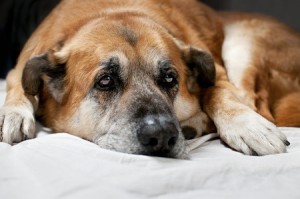 Of course, we wish our dogs would live forever, or at least as long as we do. That’s one of the downsides of owning a pet—we know we’ll have to watch our pup grow old and experience many of the same problems we ourselves face. But just as there are certain things we can do for our human loved ones, there are many things we can do to reduce the inevitable problems of aging in our dogs and make their final years as comfortable as possible.
Of course, we wish our dogs would live forever, or at least as long as we do. That’s one of the downsides of owning a pet—we know we’ll have to watch our pup grow old and experience many of the same problems we ourselves face. But just as there are certain things we can do for our human loved ones, there are many things we can do to reduce the inevitable problems of aging in our dogs and make their final years as comfortable as possible.
Eyes and Ears
Failing eyesight is part of a dog’s normal aging process. Typically, because it’s a gradual process, dogs will adjust quite well and begin to rely more on their sense of hearing. You can make life easier for your furry friend by clearing obstacles along normal pathways and block stairs, pools or other dangerous objects or areas. Reassure them by talking to them frequently and making noise while you are doing things. If you have other animals, it can help to tie bells on their collars to alert your dog of their whereabouts.
Your dog may experience hearing loss as well. If your dog doesn’t already know some hand signals, start associating them with oral commands. No more off-leash walking as your pup can’t hear traffic and can’t hear your call. Condition your older dog to an unexpected touch from behind so you can let her know you’re there and need her to move.
When vision and hearing loss happen together, it’s a little more difficult, but dogs rely heavily on their sense of smell and can get along fairly well. With a little patience and understanding and a little common sense, you’ll both figure it out.
Getting Around
You’ve probably noticed your pup isn’t moving around like she used to. Arthritis is one of the most common conditions in geriatric dogs. She may be slow to get up after napping and may have difficulty getting his footing on slick floors. Large area rugs help ease the discomfort of a hard floor and make it easier for your friend to get around. However, the rugs can slip and are difficult to clean. An alternative that works great is interlocking foam squares that you can customize to fit the area that she occupies most. Consider placing them in various areas where the family spends a lot of time.
Stairs can pose a problem for older dogs. If possible, have his bed and feeding area on the main floor. Ramps can make it easier for him to navigate short sets of steps. Ramps can also help your pup get into vehicles, and if your buddy is used to getting on your furniture and bed, a ramp will help there as well.
Arthritis often affects the bones of the spinal column, making it difficult and painful for you dog to bend her neck to eat or drink. Use an elevated dog bowl holder to reduce the strain on your pup’s neck.
When You Gotta Go
Bladder and bowel problems often accompany old age. Dogs might have trouble controlling these functions and because they no longer move as quickly, might not make it outside on time. Let your dog outside more often and watch him or her closely for signs they need to go outside. You can also use doggie diapers or purchase pads that resemble grass, and teach your dog to use them when they need to go.
Diet
Metabolism slows and the need for calories decreases as your pup ages. This is compounded by the fact their activity usually decreases as well. If you feed older dogs the same amount you fed them when they were young, they will pack on pounds, which is one of the main health problems of older dogs. Cut down on the amount you’re feeding, provide less fat and add fiber. Your veterinarian may recommend supplements both to provide for their nutritional needs as well as help with arthritis problems.
The changes that come with age are difficult and often confusing for your dog. These measures and a little extra love can go a long way toward making your furry friend more comfortable. If your pup is starting to show signs of old age, contact Powell Veterinary Service for more advice on helping you both cope.



WORKING HOURS:
Monday-Friday 8:00am - 5:00pm
Saturday 8:00am - 12:00 noon